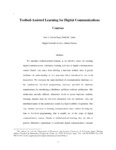Mostrar o rexistro simple do ítem
Testbed-Assisted Learning for Digital Communications Courses
| dc.contributor.author | García-Naya, José A. | |
| dc.contributor.author | Castro-Castro, Paula-María | |
| dc.contributor.author | González-López, Miguel | |
| dc.contributor.author | Dapena, Adriana | |
| dc.date.accessioned | 2015-11-10T16:17:46Z | |
| dc.date.available | 2015-11-10T16:17:46Z | |
| dc.date.issued | 2013-09 | |
| dc.identifier.citation | García-Naya, J. A., Castro, P. M., González-López, M. and Dapena, A. (2013), Testbed-assisted learning for digital communications courses. Comput. Appl. Eng. Educ., 21: 539–549. doi: https://doi.org/10.1002/cae.20499 | es_ES |
| dc.identifier.issn | 1099-0542 | |
| dc.identifier.issn | 1061-3773 | |
| dc.identifier.other | DOI: 10.1002/cae.20499 | |
| dc.identifier.uri | http://hdl.handle.net/2183/15524 | |
| dc.description | This is the peer reviewed version of the following article: Computer Applications in Engineering Education, vol. 21, no. 3, pp. 539–549, September 2013, which has been published in final form at http://dx.doi.org/10.1002/cae.20499. This article may be used for non-commercial purposes in accordance with Wiley Terms and Conditions for Self-Archiving. | es_ES |
| dc.description.abstract | [Abstract] We introduce testbed-assisted learning as an effective means for teaching digital communications. Laboratory teaching activities of digital communications courses benefit very much from utilizing a hardware testbed, since it greatly facilitates the understanding of very important effects introduced by real-world transceivers. We overcome the main drawback of communications hardware, that is, the cumbersome low-level programming interfaces provided by hardware manufacturers, by introducing a distributed multilayer software architecture. This architecture provides different abstraction levels to access hardware testbeds, releasing students from the low-level interaction with the hardware. Also, the distributed nature of this architecture results in a high flexibility of operation. This way, students can focus on learning communications topics without devoting any time to low-level programming, that is usually out of the scope of digital communications courses. Thanks to testbed-assisted learning, they are able to perform illustrative experiments to understand digital communications concepts (e.g., source coding, modulation, space-time coding, etc.) and to test algorithms without developing a new program from scratch, speeding up both the implementation and the debugging tasks. However, those students interested in hardware implementations can use the software architecture to access and interact with lower programming levels until they are as close as possible to the hardware. | es_ES |
| dc.description.sponsorship | Xunta de Galicia; PGIDIT06TIC10501PR | |
| dc.language.iso | eng | es_ES |
| dc.publisher | John Wiley & Sons | es_ES |
| dc.relation | info:eu-repo/grantAgreement/MEC//TEC2007-68020-C04-01 | |
| dc.relation | info:eu-repo/grantAgreement/MICINN/Plan Nacional de I+D+i 2008-2011/CSD2008-00010/ES/FOUNDATIONS AND METHODOLOGIES FOR FUTURE COMMUNICATION AND SENSOR NETWORKS/ | |
| dc.relation.uri | http://onlinelibrary.wiley.com/doi/10.1002/cae.20499/abstract | es_ES |
| dc.subject | Assistant tools | es_ES |
| dc.subject | Testbeds | es_ES |
| dc.subject | Multilayer architecture | es_ES |
| dc.subject | Digital communications | es_ES |
| dc.title | Testbed-Assisted Learning for Digital Communications Courses | es_ES |
| dc.type | info:eu-repo/semantics/article | es_ES |
| dc.rights.access | info:eu-repo/semantics/openAccess | es_ES |
Ficheiros no ítem
Este ítem aparece na(s) seguinte(s) colección(s)
-
GI-GTEC - Artigos [186]






